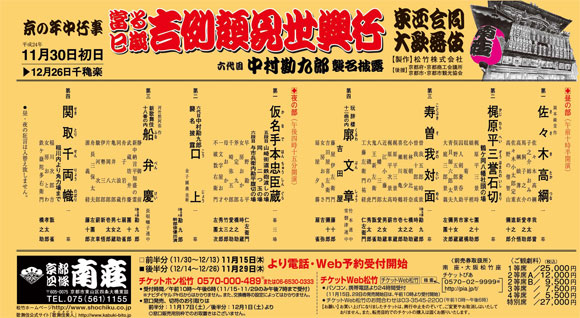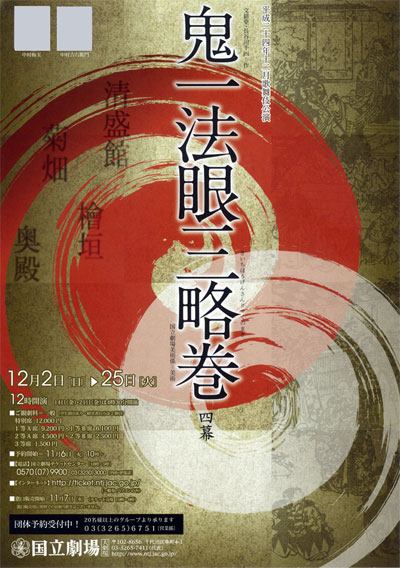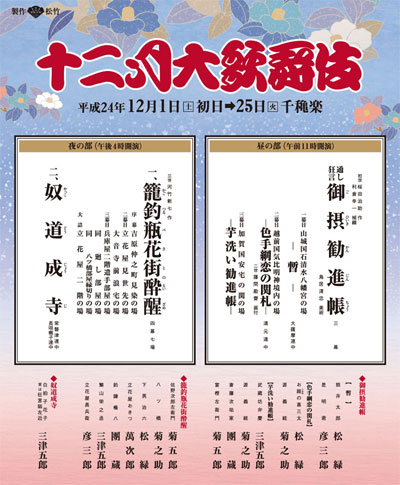| Comments |
Nakamura Kankur˘ VI celebrates his shűmei in Ky˘to at the Minamiza!
Sasaki Takatsuna: This is a modern play by Okamoto Kid˘ (1872 - 1939) who is
famous for inventing the Edo Period style detective story. Sasaki Takatsuna
shows one of the top warriors in the battles that established the Kamakura
shogunate and how he gradually becomes disillusioned with the world of lies
and political intrigue. Starring Kataoka Gat˘ in the role of Takatsuna.
Featuring also Kataoka Ainosuke, Kataoka Takatar˘ and Band˘ Yajűr˘.
Ishikiri Kajiwara: the Heike general Kajiwara (Ichikawa Danjűr˘; Nakamura Kanjaku from the 18th of December) is asked to
test the sharpness of a sword by slicing two live human beings in half.
He deliberately makes the sword fail the test to keep the sword,
a priceless heirloom belonging to the enemy Genji clan, from falling into
the hands of his Taira clan. A miracle has convinced Kajiwara to change sides.
Kajiwara finally demonstrates the true power of the sword by cutting a large stone basin in two.
Featuring also Ichikawa Sadanji, Nakamura Shichinosuke, Kataoka Ichiz˘ and Band˘ Yajűr˘.
Soga no Taimen: this is one of the oldest and most classical of all
Kabuki plays. In the Edo period, every January, plays appeared about the vendetta
carried out by the Soga brothers Jűr˘ and Gor˘ after eighteen years of hardship.
In "Soga no Taimen" the brothers confront Kud˘ Suketsune, the man responsible for
their father's death. More ceremony than play, it features each of the important
Kabuki character types, including the bombastic aragoto
style of Gor˘ and the soft wagoto style
of Jűr˘. This month features a cast headed by Kataoka Nizaemon as Kud˘
and some of the most popular young stars in Kabuki with the new Nakamura Kankur˘ as Gor˘ and
Nakamura Tokiz˘ as Jűr˘.
Yoshidaya: the roots of this play go back to the earliest days of
Kabuki. Izaemon, the son of a wealthy family, has been disowned for loving a
courtesan and now has nothing but a paper kimono. This role is a classic
example of the wagoto or soft style of
acting that is one of the representative acting styles of the Kansai region.
Sakata T˘jűr˘ stars as Izaemon, a role that is a specialty of his family's Kansai
acting style. Featuring Nakamura Senjaku as the courtesan ďgiya Yűgiri (Izaemon's lover),
Band˘ Yajűr˘ and Kamimura Kichiya as the proprietor and proprietress of the Yoshidaya teahouse.
Tepp˘ Watashi/Futatsudama/Kanpei Harakiri:
this section of the classic "Kanadehon Chűshingura" is about
Hayano Kanpei (Kataoka Nizaemon) and his wife Okaru (Nakamura Tokiz˘). Kanpei survives as a hunter and is desperate
for the money that will allow him to become a samurai again. He encounters two
former retainers of Lord En'ya Hangan who offer to allow him to participate in
a vendetta to avenge Lord En'ya Hangan's death by attacking K˘ no Moron˘.
Unknown to him, though, Okaru's family has decided to raise the memory by
selling her into prostitution as a courtesan in the Gion district of Ky˘to.
Okaru's father travels on a dark mountain road, eager to bring the first half
of the money to Kanpei. But he is attacked and robbed by Sadakur˘ (Nakamura Hashinosuke),
also a former retainer of Lord En'ya Hangan who has gone bad and become a thief.
At this point, Kanpei aims and fires at s wild boar and instead kills Sadakur˘.
He finds the purse with all the money and, thinking that is the gift of heaven,
rushes home. At home, the brothel keeper is already there to collect Okaru and
Kanpei wants to refuse to let her go, until he realizes where the money came
from and believes that he killed Okaru's father by mistake.
He urges Okaru to go to the pleasure quarters, not wanting her to know what has
happened. In one of the dramatic highlights of the play,
Kanpei commits suicide to atone for his multiple failures in duty.
K˘j˘: the close relationship between the actors and the audience
is shown by these stage announcements, lavish ceremonies to commemorate various
important events. In this case, all the stars of the cast assemble to celebrate
the shűmei of Nakamura Kankur˘ VI at the Minamiza.
Funa Benkei: although he won a war against the enemy Heike clan,
the young general Yoshitsune (Sakata T˘jűr˘) has gained the disfavor of his brother, the Sh˘gun, and tries to flee to Kyűshű by boat.
Before he sets sail, he must say farewell to his lover Shizuka (the new Nakamura Kankur˘), who performs a dance expressing her grief at their separation.
Once the boat sets sail, the spirit of the great Heike general Tomomori (the new Nakamura Kankur˘),
killed by Yoshitsune in battle at sea, appears and attacks to take revenge for the destruction of his clan.
They are only saved by the prayers of Yoshitsune's companion, the warrior-priest Benkei (Ichikawa Danjűr˘; Nakamura Hashinosuke from the 18th of December).
The roles of both Shizuka and Tomomori are played by the same actor.
Senry˘ Nobori: The sum˘tori Inagawa (Nakamura Kanjaku) has promised to give 200 ry˘
to the son of one of his major supporters. However, the only way he can fulfill this obligation is to throw his
upcoming match against his rival Tetsugadake (Nakamura Hashinosuke) but he is reluctant to cheat.
He doesn't tell his wife Otowa (Kataoka Takatar˘) about this, but she happened to overhear him making the promise, so she knows.
As Inagawa tries to decide what to do in the match with Tetsugadake, he is called to go to the arena.
Just before the match starts, Inagawa is told that an anonymous source has donated 200 ry˘.
His obligation satisfied, he can compete honestly. The match is hard-fought. Finally, Inagawa wins.
But afterwards, he is horrified to discover that the 200 ry˘ has come
from ... his wife, who had sold herself to a brothel in order to raise the money.
Sources: Earphone Guide Website or Sh˘chiku Kabuki Official Website
|


